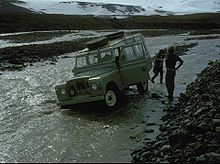| Revision as of 16:48, 22 February 2006 editReykholt~enwiki (talk | contribs)1,159 editsmNo edit summary← Previous edit | Revision as of 20:17, 7 January 2007 edit undoMike Schiraldi (talk | contribs)478 editsmNo edit summaryNext edit → | ||
| Line 1: | Line 1: | ||
| ] | |||
| The '''Highlands of Iceland''' cover most of the interior of ]. They are situated above 400-500 metres and are mostly uninhabitable, because the water coming down as rain or snow does not remain this high in the ground. It is therefore mostly a ] of grey, black or brown earth, ] and ]. A few ]-like areas, such as '']'' near ], are found only in proximity to rivers. | The '''Highlands of Iceland''' cover most of the interior of ]. They are situated above 400-500 metres and are mostly uninhabitable, because the water coming down as rain or snow does not remain this high in the ground. It is therefore mostly a ] of grey, black or brown earth, ] and ]. A few ]-like areas, such as '']'' near ], are found only in proximity to rivers. | ||
Revision as of 20:17, 7 January 2007

The Highlands of Iceland cover most of the interior of Iceland. They are situated above 400-500 metres and are mostly uninhabitable, because the water coming down as rain or snow does not remain this high in the ground. It is therefore mostly a desert of grey, black or brown earth, lava and volcanic ashes. A few oasis-like areas, such as Herðubreiðarlindir near Askja, are found only in proximity to rivers.
Icelanders categorise the Highlands as:
- "Háls", meaning a broad mountain ridge between valleys, such as the one near Langavatn north of Borgarnes; or
- "Heiði", meaning the real highlands, such as those alongside the Sprengisandur road.
Most of the numerous glaciers, such as Vatnajökull, Langjökull and Hofsjökull, are also part of the Icelandic Highlands. Vegetation is only found on the shores of the glacier rivers. There is also the danger of glacier runs.
Some of the most interesting parts of Iceland with volcanic activity are to be found in the Highlands, such as Landmannalaugar and the region around Askja and Herðubreið.

The Highlands can only be crossed during the Icelandic summer (June to August). For the rest of the year the highland roads are closed. The best known highland roads are Kaldidalur, Kjölur and Sprengisandur. Most highland roads require four wheel drive vehicles, because it is necessary to ford rivers. However, the Kjölur route can easily be traversed in an ordinary sedan and is therefore one of the more popular highland roads. Off-road driving ("road" in this context meaning tracks that are already present) is forbidden in the Highlands when they are free of snow, to protect the vegetation.
See also
External links
- Photos from www.islandsmyndir.is
- Actual road conditions (English and Icelandic)